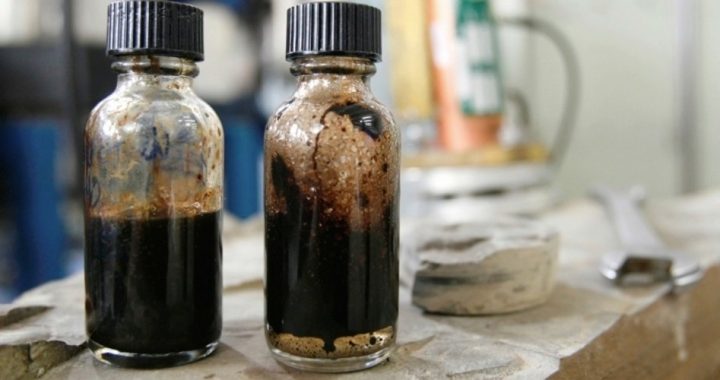
A stretch of largely vacant federal lands in Utah, Wyoming, and Colorado may hold more recoverable oil than all the rest of the world put together. That is what Anu Mittal, Director of Natural Resources for the General Accounting Office, informed the House Science Subcommittee on Energy and the Environment in her written testimony on May 10:
The Green River Formation — an assemblage of over 1,000 feet of sedimentary rocks that lie beneath parts of Colorado, Utah, and Wyoming — contains the world’s largest deposits of oil shale. USGS [U.S. Geological Survey] estimates that the Green River Formation contains about 3 trillion barrels of oil, and about half of this may be recoverable, depending on available technology and economic conditions.
The Rand Corporation, a nonprofit research organization, estimates that 30 to 60 percent of the oil shale in the Green River Formation can be recovered. At the midpoint of this estimate, almost half of the 3 trillion barrels of oil would be recoverable. This is an amount about equal to the entire world’s proven oil reserves. …
As you can imagine having the technology to develop this vast energy resource will lead to a number of important socioeconomic benefits including the creation of jobs, increases in wealth and increases in tax and royalty payments for federal and state governments.
This sounds like very good news for America. Cheap, abundant oil produced within the nation will produce high-paying jobs in the oil and gas industry, reduce the country’s balance of payments, and provide American consumers and industry with more money to spend and to expand. Ms. Mittal, however, added some caveats:
While large-scale oil-shale development offers socioeconomic opportunities it also poses certain socioeconomic challenges that also should not be overlooked. Oil shale development like other extractive industries can bring a sizable influx of workers who along with their families put additional stress on local infrastructure. Development from expansion of extractive industries has historically followed a boom-and-bust cycle making planning for growth difficult for local governments.
The federal government is in a unique position to influence the development of oil shale because nearly three-quarters of the oil shale within the Green River Formation lies beneath federal lands managed by the Department of the Interior’s (Interior) Bureau of Land Management (BLM).
Developing oil shale and providing power for oil shale operations and other activities will require large amounts of water and could have significant impacts on the quality and quantity of surface and groundwater resources. In addition, construction and mining activities during development can temporarily degrade air quality in local areas. There can also be long-term regional increases in air pollutants from oil shale processing and the generation of additional electricity to power oil shale development operations. Oil shale operations will also require the clearing of large surface areas of topsoil and vegetation which can affect wildlife habitat, and the withdrawal of large quantities of surface water which could also negatively impact aquatic life.
Despite Ms. Mittal’s cautionary comments, the aggressive recovery of these reserves could do more than simply provide the economy with large amounts of cheap oil and stimulate the oil and gas industry. Because this oil is largely on federal lands, an enormous amount of federal revenue could be generated through lease options and royalty payments without raising tax rates at all.
How much? The standard royalty payment in the oil and gas business is “one-eighth of production free and clear of costs” or 12.5 percent of the value of the oil extracted. Assuming that the 3-trillion barrel figure is accurate and that the price of oil remains in the neighborhood of $100 per barrel, then the federal non-tax revenue from royalties alone could be as high as $37.5 trillion. However, that figure is no doubt an overestimate of revenue. As more oil is extracted, the price of oil will drop, and hence it will not be economically feasible to recover more of the oil at that point.
But even if only 30 percent of those royalty revenues flowed into the U.S. Treasury, that would be enough to pay off the entire national debt without raising tax rates or cutting federal spending. Moreover, state taxes on oil and gas produced would enable state governments to keep tax rates low without affecting government operations.
The high-paying oil field jobs produced would also create more taxable income not only among those directly working in the oil industry but also in the service businesses of those states in which the oil workers lived. The oil-field workers would also pay more federal income taxes as their incomes rose, and thus the need for federal programs to assist the poor would decline.
There is mineral and energy wealth all around us. Nodules on the floors of the world’s oceans are such a source of wealth. In near space there is an asteroid 500 meters wide which has, in pure form, more platinum than has been found on all of our planet, and enterprising men are working to bring that wealth to us.
The limitations on the creation of wealth in human society seem to be only those imposed by government. If federal overregulation does not stand in the way, oil and gas extractable in North Dakota and in the Green River Formation of the Rocky Mountains may solve a whole slew of social and economic problems caused by federal deficit spending.
Photo: Vials containing oil extracted from shale are seen on a sample of shale at the CF Technologies lab in Boston, Jan. 21, 2008.: AP Images



